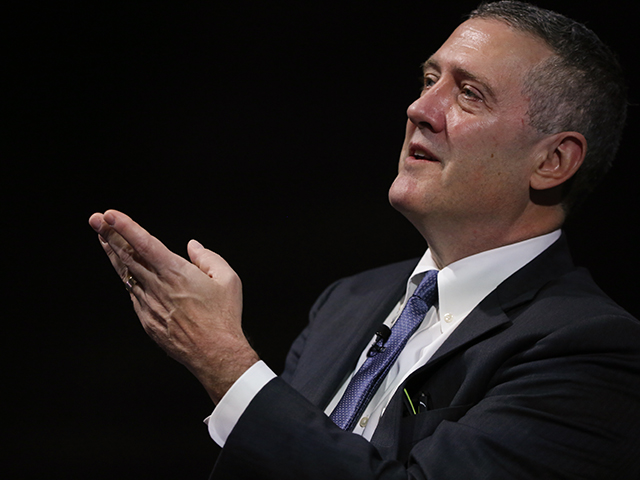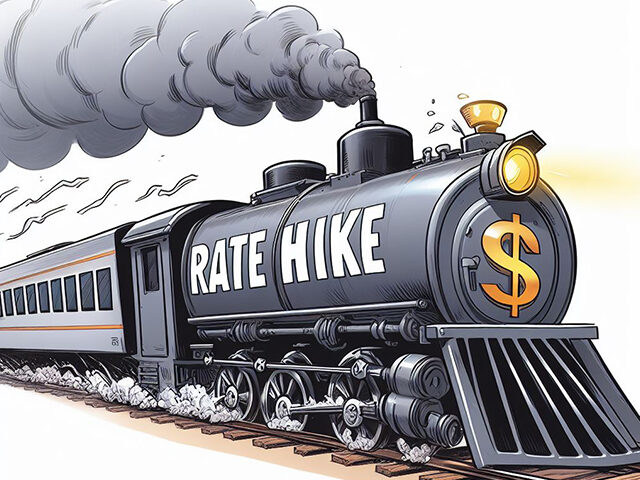All Aboard the Marrakech Express
Don’t say James Bullard did not warn you.
The former Federal Reserve Bank of St. Louis president sounded the alarm about inflation and interest rates on Friday during a seminar on the sidelines of the annual meetings of the International Monetary Fund and World Bank taking place in Marrakech, Morocco. Markets have become too complacent when it comes to inflation, with investors almost entirely discounting the idea that the U.S. central bank may have to raise rates further.
“The risk that’s underpriced in markets is that disinflation stalls out or stops altogether and core PCE inflation starts to go up again,” Bullard said, according to Bloomberg. “That would start a whole new round of consternation among policymakers about whether they’ve done enough.”

St. Louis Federal Reserve President James Bullard gestures while speaking at a conference in London on Oct. 15, 2019. (Luke MacGregor/Bloomberg via Getty Images)
Financial markets are currently pricing in almost no chance that the Fed hikes at the conclusion of its two-day meeting on November 1. This is quite extraordinary given the fact that the economic data that has come through the transom since the Fed’s last meeting suggests an economy that is gathering steam.
Is This What a Restrictive Monetary Policy Looks Like?
Job openings surged, jobless claims have remained muted, payrolls exploded higher in September, and the consumer price index (CPI) came in hotter than expected. Prices of core services excluding housing—a measure of inflation that Fed Chairman Jerome Powell has frequently drawn attention to—rose at an annual pace of 5.7 percent last month. The annualized three month rate, which is likely what Powell is really paying attention to, was up to five percent from 3.4 percent. The six-month annualized rate of Powellcore was 3.5 percent, up from 3.2 percent.
Looking into the producer price index’s intermediate demand prices, it is clear that inflationary pressures are building behind the scenes. Prices of processed goods for intermediate demand—which is government-speak for things businesses buy to produce what they sell to consumers—rose for a second consecutive month in September. The prices of service for intermediate demand went from flat month-to-month in August to rising again in September.
The Case-Shiller home price indexes rose for the sixth consecutive month in July to a new record high. Spending on residential construction grew at a seasonally adjusted rate of 0.6 percent in August, the fourth consecutive monthly rise. Single-family starts, which account for the largest segment of the economic-activity-intensive new homes market, slipped in August; but the figures were revised up for the two prior months. Permits, the leading indicator for home building, rose despite escalating mortgage rates.
The Federal Reserve Bank of Atlanta’s GDPNow gauge is estimating third-quarter GDP growth at 5.1 percent. The New York Fed staff’s nowcast has GDP growing at 2.5 percent in the third quarter and 2.3 percent in the fourth quarter.
The Fed, bond investors, and many economists believe the federal funds rate is clearly in restrictive territory already. The economic data just does not support that view.
Fed Officials Are Encouraging Complacency About Rates
However, the market has abandoned the idea that the Fed will hike at the next meeting, bringing the odds implied by prices of federal funds futures contracts from around 40 percent a month ago all the way down 7.7 percent as of Friday. The odds that the Fed hikes in December are higher, around 30 percent as of Friday, but have also declined over the month.
A good deal of this complacency has been fostered by Fed officials. Several Fed speakers have indicated that they think rates are high enough to bring inflation down to the central bank’s target over time. Many have adopted the view that the recent bond-market sell-off and rise in yields has done some of the Fed’s work. San Francisco Fed President Mary Daly recently said that the rise in yields is the equivalent of one additional Fed hike, leading many market participants to conclude that the Fed will conclude it does not need another hike this year.
The market is already racing ahead to the Fed’s next step, which many are convinced will be a rate cut. The fed funds futures market now implies around a 75 percent chance that by July of next year, the Fed will have set a target below the current range of 5.25 percent to 5.50 percent. That’s either one or two cuts next year, depending on whether you think the Fed hikes one more time before pausing.
If you really think the Fed is done with rate hikes, there’s a good deal of logic to this. As SMBC chief economist Joe Lavorga has pointed out, in the last five tightening cycles, the average length of time between the last hike and the first ease has been eight months. So, if the last hike was at July’s meeting, then the first cut should be expected in March. If the Fed hikes for a final time at the November or December meeting, the first cut would be expected in July or August.
Bullard’s point in Marrakech is that it is too early to conclude that we’ve already seen or are on the verge of seeing the last hike. If inflation starts rising again—or even just stops falling—the Fed will likely have to raise rates.
“If that happens the committee will have to contemplate going to 6 percent or 6.5 percent,” Bullard said.
We argued in Thursday’s Breitbart Business Digest that there is solid evidence that disinflation has stalled. Headline CPI shows no downward trend in the month-to-month figures. Median CPI and trimmed-mean CPI have been indicating for months that inflation may have reached a steady pace at a level significantly higher than the Fed’s target.
One measure we have not discussed much is called “sticky-price CPI,” which tracks the prices of goods and services that do not respond to market conditions as quickly as other prices. Many economists view this as a possible leading indicator of inflation because it stands to reason that when sticky prices are set, they incorporate expectations about future inflation more than flexible prices do.
The three-month annualized increase in the sticky-price CPI measure calculated by the Atlanta Fed has been on the rise for two months, hitting 4.4 percent in August. The one-month annualized rate rose to 5.4 percent. Core sticky-prices—which exclude food and energy—are up 4.5 percent on a three-month annualized basis and 5.5 percent on a one-month annualized basis. In other words, sticky-prices are saying that inflation has become stuck at a high level.
Although Bullard is no longer on the Fed, his views should not be discounted. If anything, he is likely even freer now to articulate what the Fed might do because he no longer has to worry about his views being confused with an official message from the central bank.
The most important Fed officials are the ones that just left (Bullard left in August). They are free to tell you what they think, not just spew pre-approved talking points.
*BULLARD: MARKETS UNDERPRICING RISK INFLATION RESUMES ITS RISE
*BULLARD: FED MIGHT HAVE TO HIKE TO 6% OR…
— Jim Bianco (@biancoresearch) October 13, 2023
Bullard’s message on Friday is that the Fed may start hiking again not only if inflation starts rising but also if it just stops declining. With so many measures suggesting that disinflation has already nearly run its course, that makes rate hikes next year far more likely than the less-than-zero chance bonds markets currently reflect.
Crosby, Stills, and Nash once sang that a ride aboard the Marrakech Express has the effect of “sweeping cobwebs from the edges of my mind.” If the Fed’s first move next year turns out to be a hike instead of a cut, investors will wish they had purchased their ticket to ride.

COMMENTS
Please let us know if you're having issues with commenting.